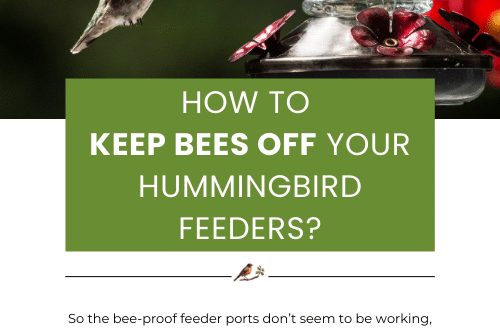-
Time to Dig Out that Window Hummingbird Feeder
 It was actually snowing today, after 3 days of spring-like 70 degree temperatures, on March 25 there were flurries in Atlanta! Will winter ever end? Migratory birds are already arriving, making their way northward from the gulf. It’s got to be a trying journey as the landscape lacks their usual finds. They’re already hungry, tired and now… there’s no food!
It was actually snowing today, after 3 days of spring-like 70 degree temperatures, on March 25 there were flurries in Atlanta! Will winter ever end? Migratory birds are already arriving, making their way northward from the gulf. It’s got to be a trying journey as the landscape lacks their usual finds. They’re already hungry, tired and now… there’s no food!Feeders help them on their way; seed feeders, suet feeders, fruit feeders, even your window hummingbird feeder. The same tiny sprites are likely to return to your yard if it offered good digs last season. It’s called site fidelity and hummingbirds practice this ritual.
The map over at hummingbirds.net shows daily sightings and locations for Ruby-Throated Hummingbirds. They’re penetrating the southeast and moving into Kentucky now. Just because it’s still cold outside it doesn’t prevent Mother Nature’s instincts from kicking into full swing! Longer daylight hours are pushing birds north to spring breeding grounds.
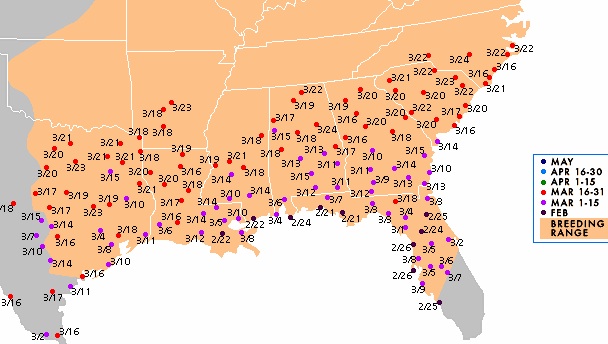 .. despite cold weather.
.. despite cold weather.Although it may not seem like hummingbird season is here – it is! Definitely time to dig out those feeders for a good cleaning and get them filled. Nectar can even be mixed a bit stronger than usual during migrations.
Your hummingbird feeder will prove to be a most welcome sight for the hungry and tired little birds. And hey, if you’re lucky enough they may even just stick around your place for the breeding season!
-
Squirrel Proof Bird Feeders for Rain, Sleet and Snow
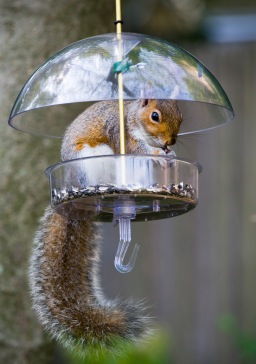 When you’ve finally had enough of squirrel’s shenanigans, you know, chasing off songbirds, stealing all the food, and those constant acrobatics including hanging upside down from your bird feeder… it might be a good time for a one-time investment in squirrel proof bird feeders. Look at this guy acting as if he owns it!
When you’ve finally had enough of squirrel’s shenanigans, you know, chasing off songbirds, stealing all the food, and those constant acrobatics including hanging upside down from your bird feeder… it might be a good time for a one-time investment in squirrel proof bird feeders. Look at this guy acting as if he owns it!Even if just one quality model that really works, absolutely lasts and has a lifetime warranty. For peace of mind and just to outwit the little critters once and for all, it’s so worth it.
Although this feeder has a dome or weather guard, it sure isn’t squirrel-proof. On the other hand, Squirrel Busters are, and they too now have an optional weather guard to keep seed dry and offer shelter while feeding.
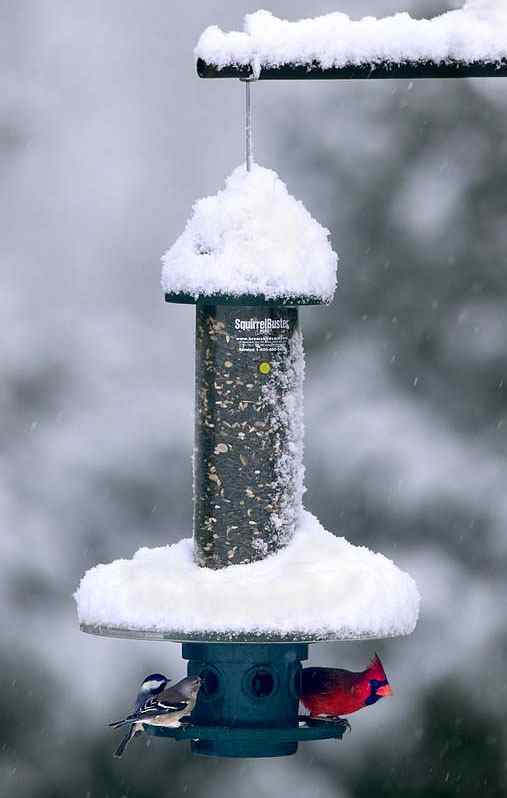
Considering the amount of snow most of the country has seen this winter (and some still seeing it) the weatherguard could actually mean the difference between a meal and starvation for some feathered friends.
Dramatic? Consider that overnight lows with sub-zero temperatures take a wicked amount of energy for a bird’s survival mechanisms. Every calorie is accounted for, just to survive each night like that. Energy’s depleted by first daylight, so when the search for food begins, accessible feeders can be the difference between life or death. Not so dramatic in warmer weather 🙂
So how do these squirrel proof bird feeders work? First, there’s no batteries or power source to mess with, that’s convenient. An adjustable weight mechanism closes off seed access to squirrels, and bigger bully-birds too. Some other cage-type feeders may operate on this same principle, but they’re not as well made and don’t carry that lifetime warranty either. Like the Postal Service motto: Through rain, sleet and snow… your birds can eat!
Check out the video below, the squirrel action doesn’t start until about midway through, but there’s some cool close-up filming of cardinals, woodpeckers, goldfinches, titmice and other friendly fliers visiting for a bite to eat.
-
Why Place Finch Feeders Near a Bird Bath?
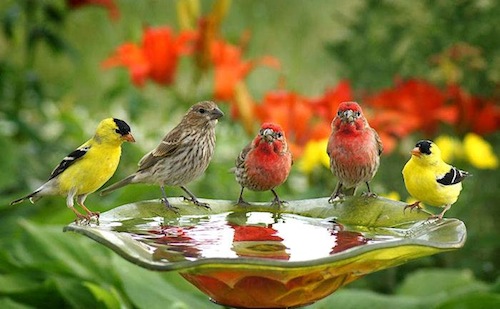
Photo courtesy of Evolve Campaigns Fresh water is known to entice more feathered friends than any single feeder or birdhouse. One of the critical elements for just about any life form, birds require fresh water, even in the harshest winter weather. Sure they can eat snow, but it takes work to convert the snow into water and uses precious calories needed to stay warm. That’s why heated baths and de-icers are so popular among dedicated backyard birders-especially this past winter, no… make that this persistent winter!
With the first bulbs forcing through, it
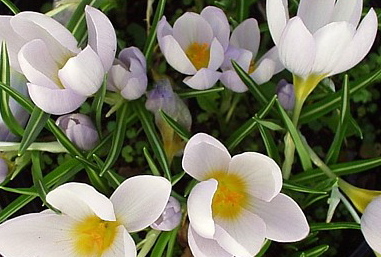 means spring’s around the corner… even if there’s still snow on the ground in your neck of the woods! The calendar and number of hours of daylight are signaling birds it’s time for nesting, to claim a spot, settle down and raise their broods. Although American goldfinches and house finches don’t use natural cavities (or birdhouses) for nesting, you can absolutely attract these cool little fliers to your place with finch feeders and a fresh water source.
means spring’s around the corner… even if there’s still snow on the ground in your neck of the woods! The calendar and number of hours of daylight are signaling birds it’s time for nesting, to claim a spot, settle down and raise their broods. Although American goldfinches and house finches don’t use natural cavities (or birdhouses) for nesting, you can absolutely attract these cool little fliers to your place with finch feeders and a fresh water source.Goldfinches can be seen chowing down on straight nyjer or thistle seed (their preferred meal), as well as finch mixes containing finely chopped sunflower hearts and thistle. The latter being more likely to attract a wider variety of species. House and purple finches, cardinals, pine siskins, towhees and several types of sparrows are commonly seen visiting finch feeders.
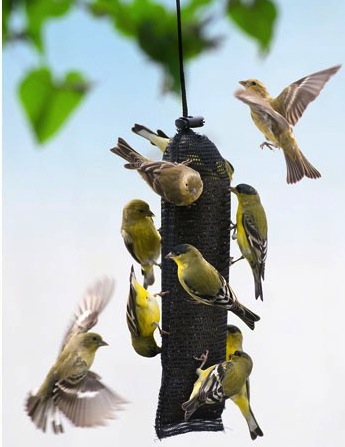 The timid demeanor of the vibrant yellow goldfinch keeps them from competing at feeders among crowds. They’d actually prefer to just give up and fly off than to fight for a chance to eat. This not very characteristic of too many birds!
The timid demeanor of the vibrant yellow goldfinch keeps them from competing at feeders among crowds. They’d actually prefer to just give up and fly off than to fight for a chance to eat. This not very characteristic of too many birds!A great way to offer extra feeding space during the busy finch season (without buying several full-blown feeders) is to offer thistle socks. Convenient and inexpensive, these smaller mesh feeders provide several birds a good meal instead of a missed opportunity!
One of very few birds who molts twice per year, their electric yellow breeding plumage has started developing. When all other birds are just about through with nesting for the season, goldfinches are just getting started! Their busy season? Late June through July.
Though they might not be sporting that amazing yellow color, goldfinches are still around. Keep thistle and finch feeders out year-round for best results, to see more of these delightful feathered friends at your place!

